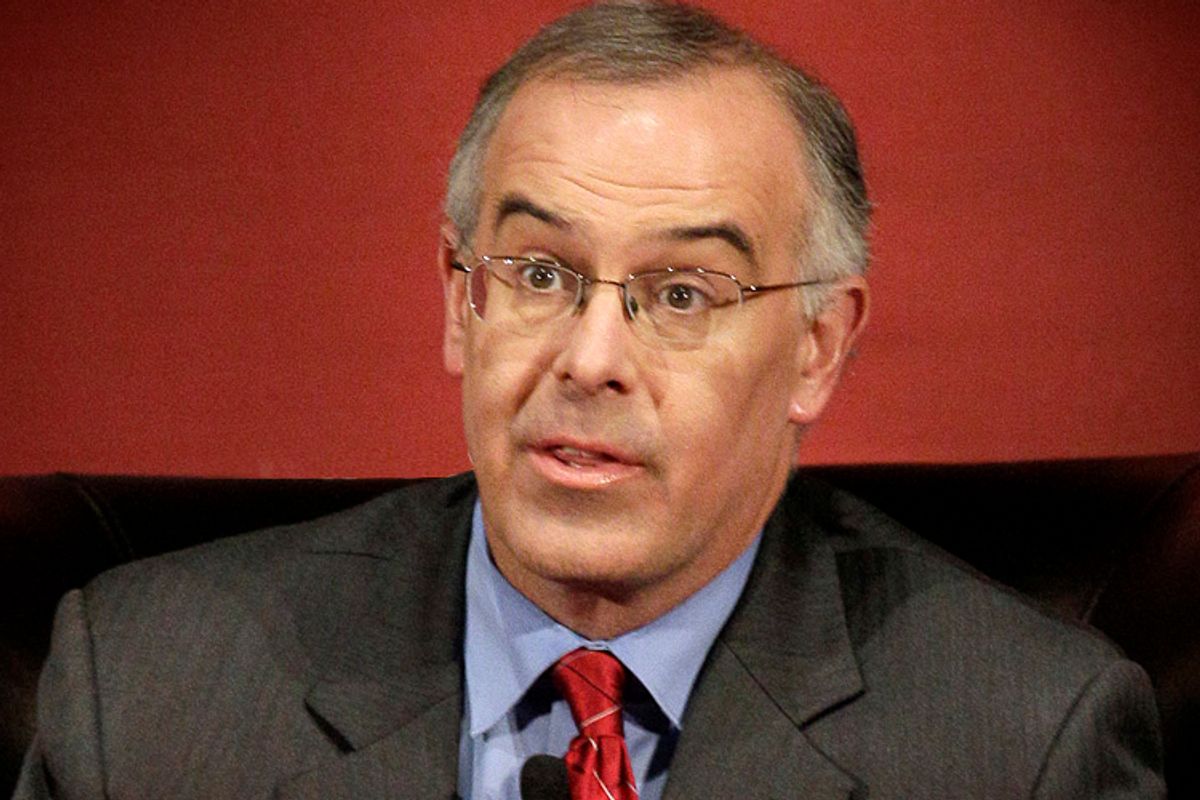New York Times columnist David Brooks has a theory about how politics will work under President Trump. Having just witnessed an election in which populist anger fueled the insurgencies of two long-shot candidates (Trump and Bernie Sanders) and toppled an establishment-favored centrist technocrat (Hillary Clinton), Brooks surmises that the future will be dominated by establishment-favored centrist technocrats, of course!
“The most important caucus formation will be in the ideological center,” he wrote in his Times column about the coming era of Trumpian politics. “There’s a lot of room between the alt-right and the alt-left, between Trumpian authoritarianism and Sanders socialism.” That centrism, Brooks wrote, is represented by — have your exasperated groans at the ready — No Labels, the gratingly centrist “activist” group that has spent six years complaining about partisanship (to no effect) while agitating for balanced budgets (also to no effect).
No Labels is quite effective, however, at slapping together gimmicky stunts meant to catch the eye of pundits like Brooks who feel that everything that’s wrong with politics can be fixed if we can just look to the vaunted center and dream really hard. No Labels’ newest pundit trap is a joint statement on “A New Center in American Politics” issued by Brookings Institute scholar Bill Galston and forever-wrong warmongering clown Bill Kristol.
The “new center,” you’ll be shocked to learn, is very much like the old center: It is ill-defined, crippled by inescapable contradictions, and unable to express itself in anything beyond vague platitudes. The only thing the new center knows for sure is that everything will be OK if we somehow get rid of partisanship:
Our form of government, in short, is fundamentally sound. Not so our parties and our politics. It is in this spirit that we make the case for a New Center, one that does not split the difference between Left and Right but offers a principled alternative to both. Its core tenets — Opportunity, Security, Accountability, and Ingenuity — can respond to the challenges of the present and chart a path to the future.
It’s the same twaddle we’ve been hearing for years from No Labels, only now the group is armed with a brand new set of false equivalencies to give it the false patina of moral superiority. “We stand together against an alternative right disdainful of the traditions of American conservatism and a vocal left that blends socialist economics with identity politics,” Galston and Kristol wrote, echoing Brooks’ alt-right/”alt-left” dichotomy.
This is completely blinkered, so let’s set a few things straight. The “alternative right” is not defined by its disdain for “the traditions of American conservatism.” It’s a racist, white-nationalist, pseudo-intellectual agglomeration of cranks and bigots who now have a direct line to the Oval Office. Only by denuding it of its core evils can one even begin to draw any sort of comparison between the “alternative right” and the “vocal left,” whose disqualifying sins apparently include pushing for universal health care and advocating on behalf of those marginalized by the political system.
But a determinedly “centrist” organization needs two poles to define itself against. Brooks and No Labels are trying to be the inoffensive middle ground between the imagined evils of Sanders-style progressivism and the concealed evils of fringe proto-fascism.
Meanwhile, the hard-line conservatives and tin-pot authoritarians who will soon be in full control of the federal government are preparing a full-scale assault on Medicare, Medicaid and voting rights. They’ll pass huge tax cuts for the wealthy and pretend to pay for those cuts by gutting the welfare state. Wall Street will be deregulated and proper health coverage will become harder to get.
Will the “new center” stand in opposition to any of this? Of course not. Opposing those things would reek of partisanship, which is the great evil of centrism. No Labels and the rest of the centrist bleaters will instead celebrate the transparently false promises of a balanced budget that will surely attend all this ideological warfare.
But let’s get back to Brooks, who lays out the challenges facing this “new center” at the moment of its inception:
First, deepen a positive national vision that is not merely positioning between left and right. Second, elevate a new generation of political leaders so the movement is not just a retread of retired establishment types.
Third, build a mass movement of actual voters, not just financiers and think-tank johnnies. Fourth, have the courage to stand together as a swing legislative caucus, when the pressure from the party leaderships becomes intense.
No Labels has been trying and failing to do this for several years now because it stands for nothing other than not being “partisan.” Toothless centrism appeals exclusively to “retired establishment types,” financiers and “think-tank johnnies” precisely because it is divorced from practical concerns: When you don’t have to worry about rising health insurance premiums or unaffordable mortgage payments, it’s easier to think of a balanced federal budget as the greatest good that government can aspire to.
Brooks seems to think there’s a hidden appetite for this flavor of politics. He’s already talking about dynamic new leaders and a “swing legislative caucus” of centrists. But the centrists themselves can’t even explain what this “movement” is supposed to be about. “We do not know what policies a New Center will yield,” Galston and Kristol wrote. “Nor can we predict what institutional form or even party alignment it will take.”
There’s no platform, coherent structure, intellectual drivers and constituency for this incipient wave of new centrism. So what are we even doing here? Well, a New York Times op-ed makes for great fundraising material, and if there’s one thing No Labels is good at, it’s raising money for itself.



Shares